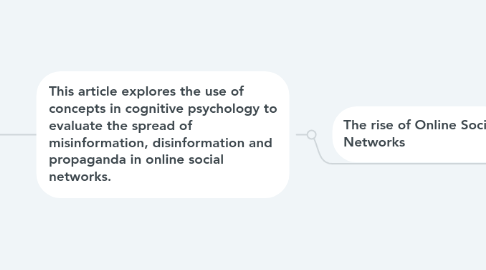
1. This article explores the use of concepts in cognitive psychology to evaluate the spread of misinformation, disinformation and propaganda in online social networks.
1.1. The rise of Online Social Networks
1.1.1. Online Social Networks (OSN) have become an important source of information for a large number of people in the recent years. As the usage of social networks increased, the abuse of the media to spread disinformation and misinformation also increased many fold.
1.1.1.1. It is essential to understand the related concepts of information, misinformation, disinformation and propaganda:
1.1.1.1.1. The presence of misinformation in the society and real world social networks have been studied from psychological point of view extensively. As per the authors, the spread of misinformation is a result of a cognitive process by the receivers based on their assessment of the truth value of information. Acceptance of information is more the norm than otherwise for most of the people.
1.1.1.1.2. Misinformation is false or inaccurate information, especially that which is deliberately intended to deceive.
1.1.1.1.3. Disinformation is false information that is intended to mislead, especially propaganda issued by a government organization to a rival power or the media.
1.1.1.1.4. Propaganda is defined as information, especially of a biased or misleading nature, used to promote a political cause or point of view.
1.1.1.2. The authors examined the information propagation pattern in Twitter to detect the spread of misinformation. The cognitive psychology analysis revealed that source of information is an important factor to be considered while evaluating the credibility. Moreover, the difference between misinformation and disinformation is in the intention of the source in spreading false information.
1.1.1.2.1. The researchers goal was to create an algorithm that could effectively detect deliberate spread of false information which would enable users to make informed decisions while spreading information in social networks. The algorithm uses the collaborative filtering property of social networks to measure the credibility of sources of information as well as quality of news items.
